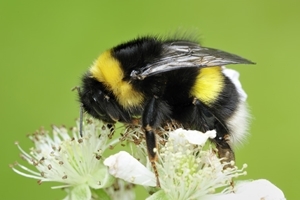 The majority of herbaceous flowering plants benefit from being insect pollinated and for some crops this is crucial, not only ensuring seed and fruit set, but also increasing yields. In return, the pollinators gain a valuable source of energy and nutrients. Indeed for some insects (e.g. hoverflies and parasitic wasps), eggs can only be produced if they obtain the nutrients provided by flowers. A wide variety of insects visit flowers and on farmland these include bees, butterflies, moths, flies and beetles. To ensure their survival it is important to provide a wide variety of flowering plants and that flowers are available for as long as possible through the year.
The majority of herbaceous flowering plants benefit from being insect pollinated and for some crops this is crucial, not only ensuring seed and fruit set, but also increasing yields. In return, the pollinators gain a valuable source of energy and nutrients. Indeed for some insects (e.g. hoverflies and parasitic wasps), eggs can only be produced if they obtain the nutrients provided by flowers. A wide variety of insects visit flowers and on farmland these include bees, butterflies, moths, flies and beetles. To ensure their survival it is important to provide a wide variety of flowering plants and that flowers are available for as long as possible through the year.
Trees, shrubs and herbaceous plants can all be used to supply flowers. It is therefore important that existing flower-rich areas are appropriately managed including woodland, hedgerows and semi-natural grassland and that any new plantings such as pollen and nectar or wildflower areas include a diversity of flowering species. The use of different habitat types by pollinators was investigated in the Farm4Bio project.
Pollinators are under threat throughout the world, and the GWCT is using our knowledge of long-term monitoring and habitat enhancement in a Darwin Initiative funded project on people and pollinators in India.